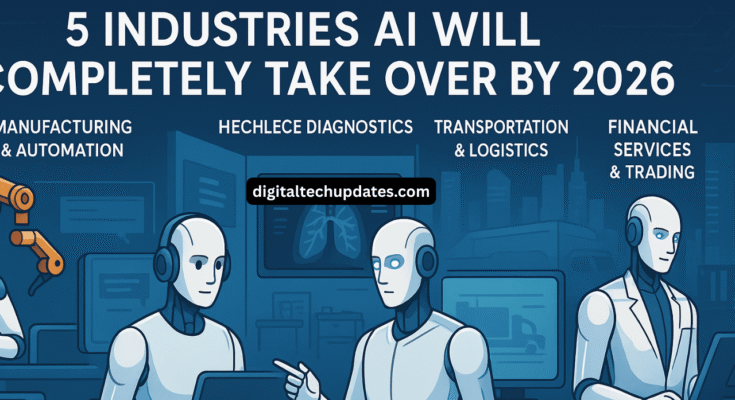Introduction:
Artificial Intelligence (AI) has rapidly evolved from a futuristic concept into a core driver of innovation across industries. From voice assistants and chatbots to autonomous vehicles and medical imaging, AI has permeated almost every aspect of our lives. As we move toward 2026, its influence is expected to be even more profound, fundamentally reshaping how businesses operate and deliver value. This article explores five industries where AI is not just a tool—but a game-changing force that will completely take over by 2026.
Manufacturing & Automation
Why Manufacturing? Manufacturing has always been at the forefront of technological innovation, and AI is taking this sector to new heights. Traditional factory floors are evolving into smart factories, powered by robotics, machine learning algorithms, and IoT sensors.
Key AI Technologies Driving the Shift:
- Predictive maintenance using machine learning
- AI-powered robotics for assembly lines
- Quality control via computer vision
- Supply chain optimization through data analytics
Benefits:
- Reduced human error and operational costs
- Increased efficiency and production speed
- Real-time decision-making capabilities
Concerns:
- Job displacement for manual labor
- Dependence on AI infrastructure
Customer Service & Call Centers
Why This Industry? Customer service is increasingly becoming digitized. AI is transforming call centers into intelligent service hubs with virtual agents and chatbots capable of handling millions of queries simultaneously.
Key AI Technologies Driving the Shift:
- Natural Language Processing (NLP)
- Sentiment analysis
- AI chatbots and voice bots
- Automated ticketing systems
Benefits:
- 24/7 availability
- Faster query resolution
- Cost savings for businesses
Concerns:
- Loss of human touch
- Privacy and data handling concerns
Healthcare Diagnostics
Why Healthcare? AI is already making waves in healthcare, particularly in diagnostics and patient care. With the ability to analyze massive datasets quickly and accurately, AI is redefining how diseases are detected and managed.
Key AI Technologies Driving the Shift:
- Machine learning for disease detection (e.g., cancer, diabetes)
- Image recognition in radiology and pathology
- Predictive analytics for treatment plans
- AI-powered robotic surgeries
Benefits:
- Early and accurate diagnosis
- Improved patient outcomes
- Reduced workload for doctors
Concerns:
- Ethical concerns around decision-making
- Data security and patient privacy
Transportation & Logistics
Why Transportation? From autonomous vehicles to AI-powered logistics platforms, the transportation industry is on the brink of an AI revolution. AI enables smarter route planning, real-time trafficjobs replaced by AI management, and autonomous delivery systems.
Key AI Technologies Driving the Shift:
- Self-driving vehicle systems
- AI-based route and fleet optimization
- Predictive maintenance for vehicles
- Real-time cargo tracking
Benefits:
- Lower operational costs
- Improved delivery efficiency
- Safer transportation networks
Concerns:
- Regulation and liability in case of failure
- Loss of driving jobs
Financial Services & Trading
Why Finance? AI is revolutionizing financial services by automating tasks, enhancing decision-making, and managing risk. Algorithms can now predict market trends, detect fraud, and provide personalized financial advice at scale.
Key AI Technologies Driving the Shift:
- Algorithmic trading
- Fraud detection using AI pattern recognition
- Robo-advisors for personal finance
- AI-powered underwriting and credit scoring
Benefits:
- Faster and data-driven decisions
- Reduced fraud and financial crimes
- Better customer personalization
Concerns:
- Algorithmic biases
- Market manipulation risks
Conclusion
By 2026, AI will have a dominant presence in manufacturing, customer service, healthcare, transportation, and finance. Businesses that adapt to this transformation will thrive, while those that resist may struggle to stay relevant. Although challenges like job displacement and ethical dilemmas exist, the potential for innovation and efficiency is unparalleled. The age of AI is not coming—it’s already here, and by 2026, its footprint will be undeniable.




